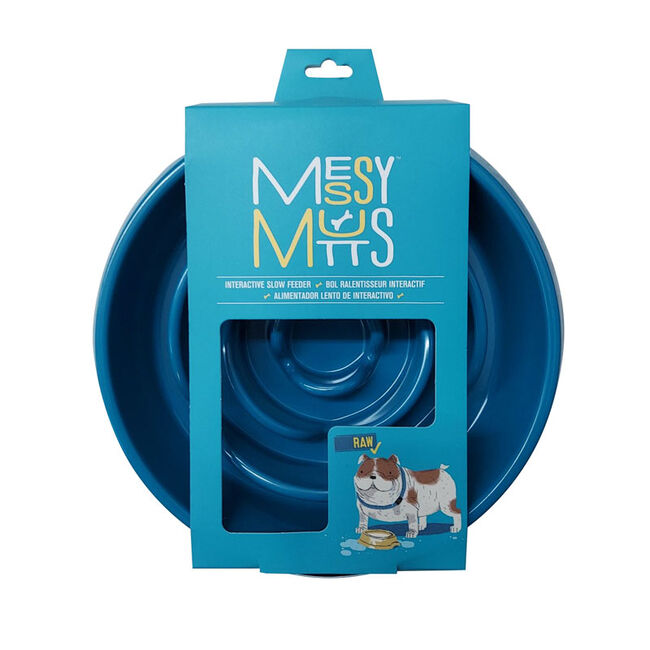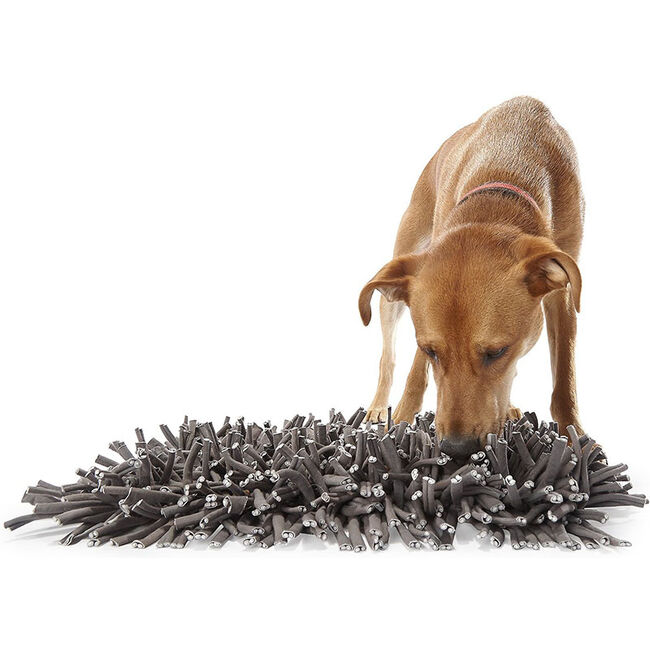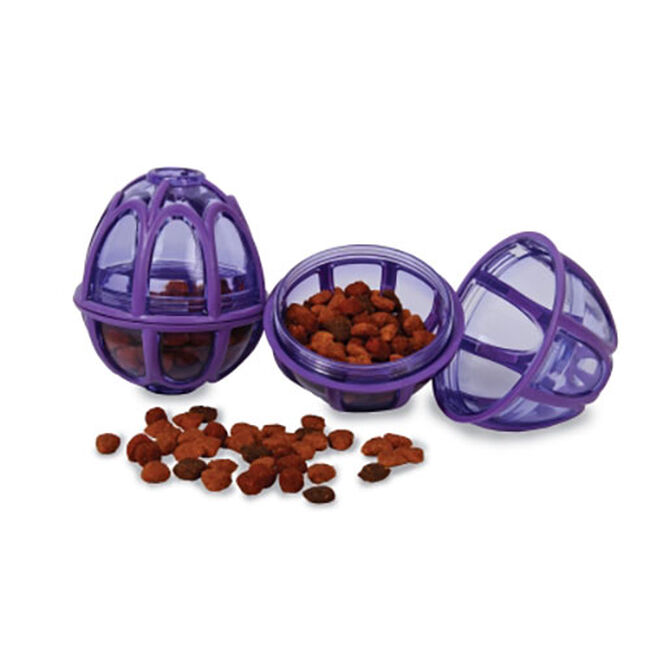
It’s a fact, dinner time is one of the most exciting moments of the day for many pups. It is also a wonderful time for dog owners, knowing that they are giving their canine companions the nutrition and calories that they need to thrive. However, some dogs devour their meals in a matter of seconds, making short work of dinner time which can be risky for their health. For dogs that eat quickly or “bolt” their food, canine slow feeders are a great option. Keep reading to better understand the health benefits of encouraging your dog to eat more slowly and the products that can assist you.
When dogs eat their meals too quickly, their digestive system is not always prepared to intake the foodstuffs in such a rapid manner. By ingesting their food so fast, they may not be able to properly chew or digest the food and can also take in large amounts of air. Additionally, dogs that eat too quickly are more likely to develop Gastric Dilatation-Volvulus (GDV), more commonly known as Bloat. When a dog Bloats, its stomach completely fills with gas, fluid, food, or a combination of all three. This causes the dog’s stomach to flip or twist. This action requires immediate medical attention — often surgery — for the best chance of your dog’s survival. Many dogs go into shock when they Bloat, which makes the condition even more dangerous. Large dogs with deep chests, such as Great Danes and Greyhounds, and dogs with voracious appetites, like Labrador Retrievers, are at the greatest risk of Bloat, but any dog can be affected. Some veterinarians estimate that over 60,000 dogs are affected by Bloat each year.
A slow feeder is an easy, affordable, effective way to safeguard against deadly conditions like Bloat. The American Kennel Club (AKC) reports that dogs that eat rapidly are five times more likely to experience Bloat than dogs that eat in a slower manner. Utilizing products that encourage slower eating means that your dog inhales less air as they eat, while also giving the dog’s stomach more time to accommodate their meal. By making your dog think about the food that they are eating, slow feeders encourage more natural and deliberate eating patterns. Many dog owners also choose to serve their dogs multiple, smaller meals throughout the day to minimize anxiety around eating while also, hopefully, preventing stomach distention.
Because all dogs are at risk of Bloat, it makes sense to take the proper precautions against this extremely dangerous and life-threatening condition. In addition to utilizing a slow feeder, it is important to discourage heavy exercise on a full stomach, as well as restrict activity for a few hours after your dog has eaten. Be cognizant of your dog’s water intake as well, because too much water too quickly can also cause Bloat. Be sure to monitor your dog for symptoms on a daily basis, including restlessness, a swollen or painful abdomen, excessive drooling, rapid breathing, dry heaving, collapse, or inability to stand. If your dog exhibits these symptoms, they should be immediately seen by a veterinarian. Bloat is always an emergency; according to the AKC, it is fatal for over 30% of the dogs that are affected, even with proper treatment.
Eating more slowly has also been shown to lessen vomiting, especially in dogs that eat so quickly that they are unable to digest the food and shock their digestive system. The longer that it takes for your dog to consume their foodstuffs, the more likely it is that they are properly digesting their meal.
According to the American Veterinary Medical Association (AVMA), “Eating too quickly can cause problems other than obesity and Bloat. Slow feeder bowls and meal dispensing dog toys or puzzles require dogs to eat more slowly, engage mental effort and increase activity, which in turn burns calories.” Slow feeders provide canines with much-needed mental stimulation, especially during the fall and winter months when dogs may be spending more time in the house. Many of the slow feeder products have an interactive element to them, which makes eating take longer while also making it a whole lot of fun! For some dogs, slow feeders have a calming effect and can decrease food-based anxiety. You can learn more about ways to keep your dog entertained in the house by reading our blog post, Providing Mental Stimulation to Your Canine Companion.
They can also benefit your dog’s weight in a positive way. Many dog owners with overweight dogs report that their dogs gradually lose weight because they think that they are eating more food. On the other hand, for dogs who are generally disinterested in their foods, slow feeders can be an effective way to add some excitement to mealtime; by making them think about the challenge of eating, these dogs tend to ingest more foodstuffs over time. However, if your dog is underweight, a slow feeder could cause them to lose interest in eating because it is too difficult; these dogs will require additional monitoring at mealtimes. If your dog is struggling with weight, it is a good idea to speak to your veterinarian to make sure that a slow feeder is appropriate for your dog.
Whatever your reason is for choosing a slow feeder, it is important to select a slow feeder that matches your dog’s level of intelligence, food motivation, and type of food. Slow feeders that are too difficult to master may deter your dog from eating, however, if the design of your feeder is too simple, it may not slow down your dog’s rate of consumption as much as you desire.
Slow Feeder Bowls are the most common type of slow feeder that is used by our customers. These durable plastic bowls have raised obstructions that force your dog to eat around them. The bowls come with a variety of barrier patterns, ranging from easy to difficult. The Messy Mutts Interactive Slow Feeder is appropriate for dry food, wet food, and raw food, the unique ridges prevent your dog from bolting his or her food while encouraging slow bites. The Zippy Paws Slow Feeder Ice Cream Bowl showcases a cute design that will make you smile each time you feed your four-legged friend; additionally, Zippy Paws reports that dogs eat up to 10 times slower with this bowl than they do with traditional bowls.
Messy Mutts 3 Cup Capacity Interactive Slow Feeder
This bowl features multiple raised barriers around your dog’s food, encouraging them to “hunt” for each bite.
Snuffle Mats help your canine get in touch with their natural foraging instincts. The thick carpeting makes your dog utilize their nose to locate the dog food or dog treats which mimics the action of hunting in tall grass. Simply pour the kibble or a few treats onto the mat and run your fingers over it a few times to “hide” the food in the thick tendrils of the mat. The PAW5 Wooly Snuffle Dog Feeding Mat utilizes sustainably sourced non-toxic materials which are machine washable. This easy-to-care-for mat is appropriate for dogs of all breeds and sizes.
PAW5 Wooly Snuffle Dog Feeding Mat
This feeding mat stimulates a dog’s natural foraging instincts by mimicking the hunt for food in grass and fields,
For dogs that eat wet dog food or are fed soft supplements, Interactive Feed Mats are a terrific choice. Simply spread your dog’s daily rations onto the mat and watch them contort their tongue as they lick up every morsel of the meaty goodness. For an additional level of difficulty, consider freezing the mat, which will make additional lick necessary to thaw the food. The Messy Mutts Silicone Therapeutic Feeding Mat encourages therapeutic licking, which can have a calming effect for many dogs. For dogs with broths or other wet foods in their diet, the Messy Mutts Therapeutic Lick Bowl Mat is a wonderful hybrid option, giving you the fun of a feed mat combined with the functionality of a dog bowl. As an added benefit, all of these are dishwasher safe… which makes cleaning up after mealtime a breeze!
Messy Mutts Silicone Therapeutic Feeding Mat with Silicone Spatula
Perfect for delivering supplements, milks, broths, or just plain peanut butter and yogurt while prolonging their enjoyment!
Puzzle Feeders are the perfect option for highly intelligent dogs or those who are highly food motivated. These feeders encourage your dog to perform specific tasks in order to access their meal. For example, the PAW5 Rock ‘N Bowl Puzzle Feeder hides the food in the base; in order to eat, your dog must nuzzle, paw, and flip the bowl to release the dry dog kibble. Part dinner time, part playtime, this feeder encourages your dog to be more active while also drastically increasing the amount of time that it takes your dog to eat their meals.
PAW5 Rock ‘N Bowl Puzzle Feeder
This unique puzzle feeder will have your dog thinking, problem-solving, and having fun all at once.
Treat-Dispensing Toys are a great way to keep your dog actively engaged with their toy, while also rewarding them with tasty treats or pieces of dog kibble. These toys require the dogs to move them in a variety of ways in order to access their delicious snack or meal. PetSafe Busy Buddy treat-dispensing toys are large enough to hold your dog’s entire meal, which can extend the amount of time it takes your dog to eat by a considerable amount. For dogs who are tough on their toys, the Starmark Treat Dispensing Chew Ball Dog Toy can keep your dog entertained, which can be extremely beneficial when trying to curb destructive behaviors.
PetSafe Busy Buddy Treat Dispensing Kibble Nibble Dog Toy
The customizable dual treat meters on this toy randomly dispense kibble or treats as your dog tumbles the ball around.
From prevention of a life-threatening digestive disorder to mental stimulation and weight management, slow-feeding products benefit almost every dog. Consider integrating a slow feeding bowl, snuffle mat, interactive feed mat, treat-dispensing toy, or puzzle feeder into your dogs’ meal time to change up their feeding routine.
When introducing a slow feeder to your dog, it is essential that they understand the new feeding practice and still have access to quality nutrition. If you notice that your dog is no longer able to finish its meal, you may have selected a slow-feeding product that is too difficult for your dog. It is important to monitor your dog closely, especially during the introduction phase. Our experienced and friendly sales staff is always available to help you select the best slow feeder for your dog. We encourage you to consult with your veterinarian if you have any questions regarding the appropriateness of slow feeders for your individual dog.






My puppy had the wooly snuffle rug and while it works well when puppy is young, adolescent dogs can pull the individual pieces of “grass” -like matt “fingers” off. Not for aggressive chewers, needs monitoring and may have limited age use.